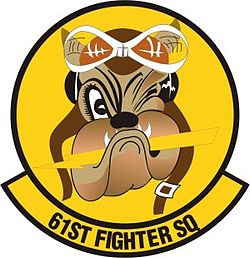| 61st Fighter Squadron | |
|---|---|
 61st Fighter Squadron Patch | |
| Active | January 15, 1941 – October 18, 1945 May 1, 1946 – July 25, 1960 June 30, 1975 – August 12, 1993 April 1, 1994 – Present |
| Country | United States |
| Branch | United States Air Force |
| Type | Fighter Training |
| Part of | Air Education and Training Command 19th Air Force 56th Fighter Wing 56th Operations Group |
| Garrison/HQ | Luke Air Force Base |
| Nickname(s) | Top Dogs |
| Decorations | |
| Commanders | |
| Notable commanders | Gabby Gabreski Michael Ryan |




The 61st Fighter Squadron (61 FS) is an inactive United States Air Force unit, last assigned to the 56th Operations Group, at Luke Air Force Base, Arizona. It operated the F-16 Fighting Falcon aircraft, conducting advanced fighter training until its deactivation on 27 August 2010.
Mission
Until its inactivation, the 61 FS known as the 'Top Dogs' flew a mix of F-16C/D Block 42 aircraft, to train pilots for Air Combat Command assignments.
History
The 61st Pursuit Squadron (Interceptor) was constituted on November 20, 1940 and activated on January 15, 1941, in Savannah, Georgia, training in P-39 Airacobra and P-40 Warhawk aircraft. The 61st later moved to Charlotte, North Carolina, in May 1941 and again to Charleston, South Carolina, in December 1941, to help defend the East Coast. In November 1942, P-47 Thunderbolt dive test pilots achieved 725 mph, faster than the speed of sound. In 1944, it was recognized as the first fighter squadron in the European theater to score over 100 victories. From 1943 to 1945, the 61st produced 19 Aces, the highest of any squadron in Europe, destroying 248 aircraft in the air and 67.5 aircraft on the ground.[1]
The squadron was deactivated October 1945 at Camp Kilmer, New Jersey and reactivated at Selfridge Field, Michigan training in P-47's while transitioning to P-51 Mustangs. In April 1950, the 61st transitioned to the F-94 modified with radar, operated by a RO (Radar Observer) to serve as an All Weather fighter Interceptor. In 1953 the Squadron was relocate to Ernest Harmon AFB in Newfoundland where it became part of the DEW (Defense Early Warning) system. The F-94 all weather fighter interceptors were later replaced with the F-89 all weather fighter interceptors. In 1957 the squadron was relocated to Truax Field. The 61st transitioned to the F-80 Shooting Star and later was the first squadron to fly the F-86 Sabre. The 61st was deactivated on July 25, 1960, at Truax Field, Wisconsin flying the F-102 Delta Dagger. In June 1975, the 61st was reactivated at MacDill Air Force Base, Florida, flying the F-4 Phantom II. In April 1980, the flying mission changed to the F-16 Fighting Falcon. The 61st transitioned in June 1988 to flying the F-16 C/D and the squadron was deactivated in January 1994. The squadron was reactivated on April 1, 1994 at Luke Air Force Base, Arizona, replacing the former 314th Fighter Squadron flying the F-16 C/D Fighting Falcon.[1]
Lineage
- Constituted as 61st Pursuit Squadron (Interceptor) on 20 Nov 1940
- Activated on 15 Jan 1941
- Re-designated: 61st Pursuit Squadron (Interceptor) (Twin Engine) on 31 Jan 1942
- Re-designated: 61st Fighter Squadron (Twin Engine) on 15 May 1942
- Re-designated: 61st Fighter Squadron on 1 Jun 1942
- Re-designated: 61st Fighter Squadron, Single Engine, on 28 Feb 1944
- Inactivated on 18 Oct 1945
- Activated on 1 May 1946
- Re-designated: 61st Fighter Squadron, Jet Propelled, on 24 Apr 1947
- Re-designated: 61st Fighter Squadron, Jet, on 14 Jun 1948
- Re-designated: 61st Fighter-Interceptor Squadron on 20 Jan 1950
- Discontinued, and inactivated, on 25 Jul 1960
- Re-constituted and re-designated as 61st Tactical Fighter Squadron on 12 May 1975
- Activated on 30 Jun 1975
- Re-designated: 61st Tactical Fighter Training Squadron on 1 Jan 1980
- Re-designated: 61st Fighter Squadron on 1 Nov 1991
- Inactivated on 12 Aug 1993
- Activated on 1 Apr 1994
- Inactivated on 27 August 2010
Assignments=
- 56th Fighter Group (1941–1945)
- 56th Fighter-Interceptor Group (1946–1952)
- 4708th Defense Wing (1952–1953)
- 575th Air Defense Group (1953)
- 64th Air Division (1953–1957)
- 4731st Air Defense Group (1957)
- 327th Fighter Group (1957–1960)
- 56th Fighter Wing (1975–Present)
Stations
|
|
Aircraft
|
|
Operations
References
Notes
- ^ a b 56 OG Fact Sheet
- ^ a b c d e AFHRA 61 FS Page
Bibliography
See also
| Air Forces | ||
|---|---|---|
| Bases | ||
| Wings | ||
| Groups | ||




